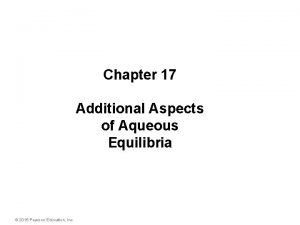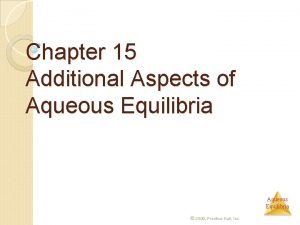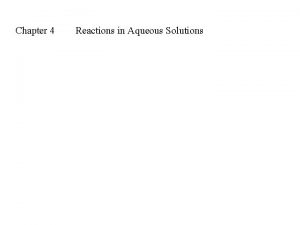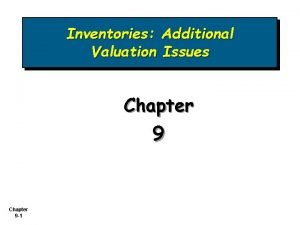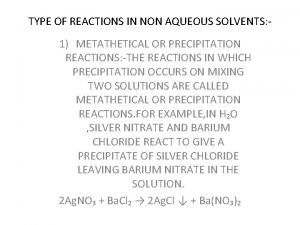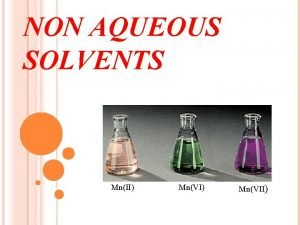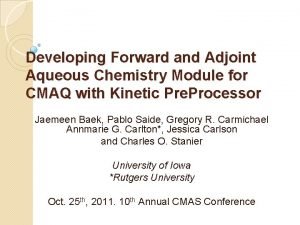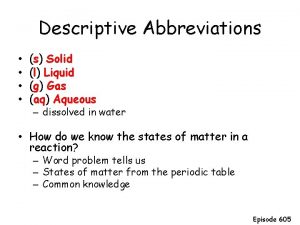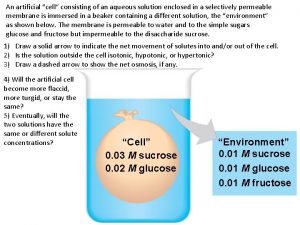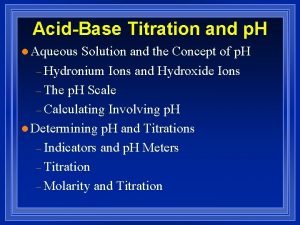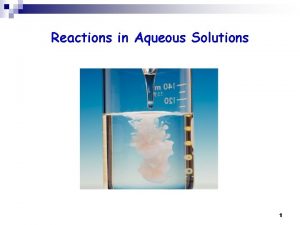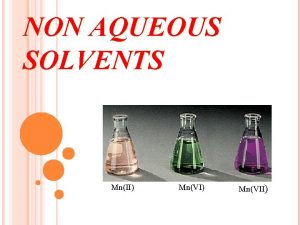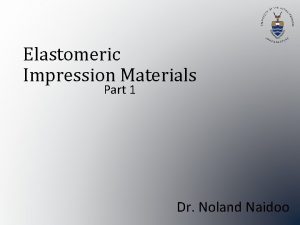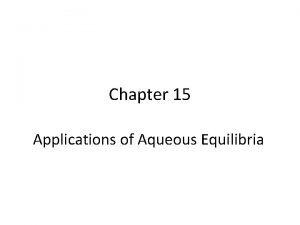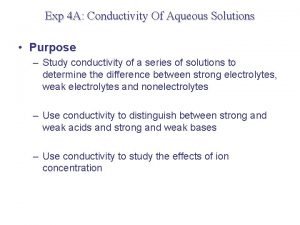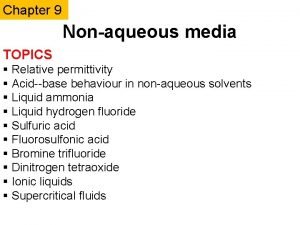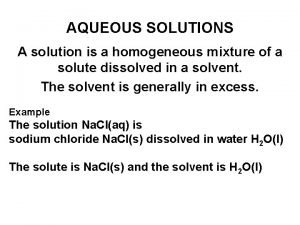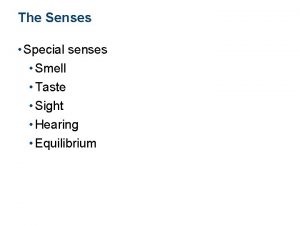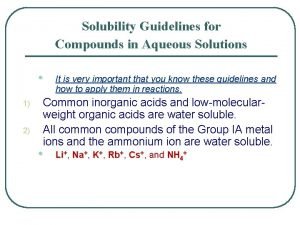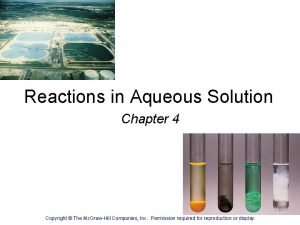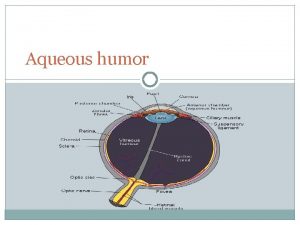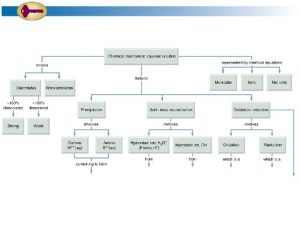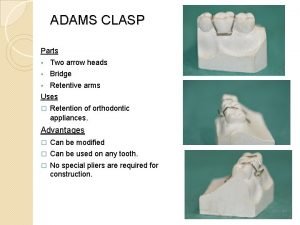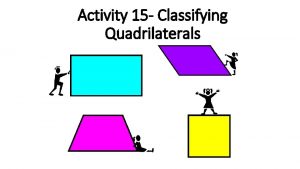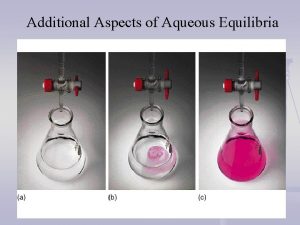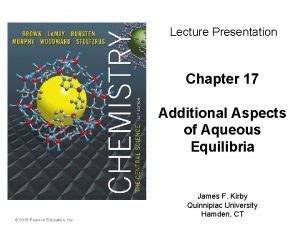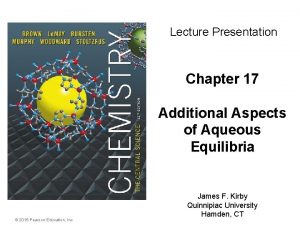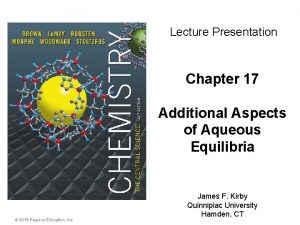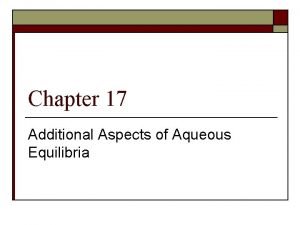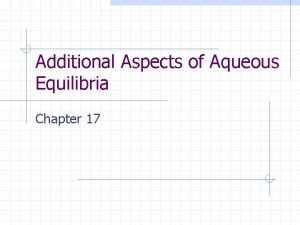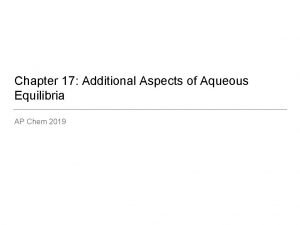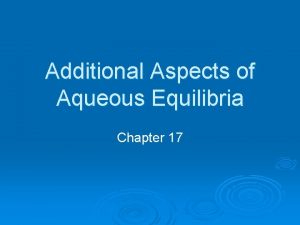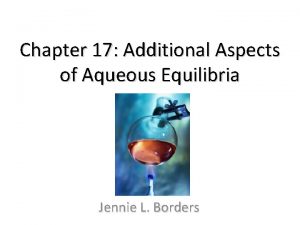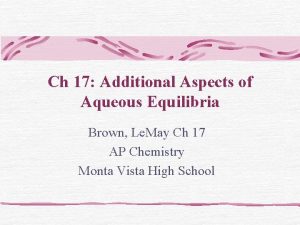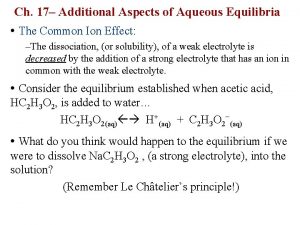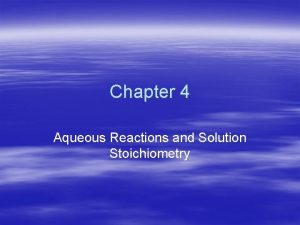Lecture Presentation Chapter 17 Additional Aspects of Aqueous











![The Common-Ion Effect • Therefore, [F ] = x = 1. 4 10 3 The Common-Ion Effect • Therefore, [F ] = x = 1. 4 10 3](https://slidetodoc.com/presentation_image_h/2b70283bdcfbed5129a82e2b6bf0e07b/image-12.jpg)




![Buffer Calculations Rearranging slightly, this becomes ] [A Ka = [H 3 O+] [HA] Buffer Calculations Rearranging slightly, this becomes ] [A Ka = [H 3 O+] [HA]](https://slidetodoc.com/presentation_image_h/2b70283bdcfbed5129a82e2b6bf0e07b/image-17.jpg)
![Buffer Calculations • So [base] p. Ka = p. H log [acid] • Rearranging, Buffer Calculations • So [base] p. Ka = p. H log [acid] • Rearranging,](https://slidetodoc.com/presentation_image_h/2b70283bdcfbed5129a82e2b6bf0e07b/image-18.jpg)

![Henderson–Hasselbalch Equation [base] p. H = p. Ka + log [acid] p. H = Henderson–Hasselbalch Equation [base] p. H = p. Ka + log [acid] p. H =](https://slidetodoc.com/presentation_image_h/2b70283bdcfbed5129a82e2b6bf0e07b/image-20.jpg)






























![Solubility Products The equilibrium constant expression for this equilibrium is Ksp = [Ba 2+] Solubility Products The equilibrium constant expression for this equilibrium is Ksp = [Ba 2+]](https://slidetodoc.com/presentation_image_h/2b70283bdcfbed5129a82e2b6bf0e07b/image-51.jpg)
























- Slides: 75

Lecture Presentation Chapter 17 Additional Aspects of Aqueous Equilibria © 2012 Pearson Education, Inc. John D. Bookstaver St. Charles Community College Cottleville, MO

The Common-Ion Effect • Consider a solution of acetic acid: CH 3 COOH(aq) + H 2 O(l) H 3 O+(aq) + CH 3 COO (aq) • If acetate ion is added to the solution, Le Châtelier says the equilibrium will shift to the left. Aqueous Equilibria © 2012 Pearson Education, Inc.

The Common-Ion Effect “The extent of ionization of a weak electrolyte is decreased by adding to the solution a strong electrolyte that has an ion in common with the weak electrolyte. ” Aqueous Equilibria © 2012 Pearson Education, Inc.

Sample Exercise 17. 1 Calculating the p. H When a Common Ion is Involved What is the p. H of a solution made by adding 0. 30 mol of acetic acid and 0. 30 mol of sodium acetate to enough water to make 1. 0 L of solution? Solution Analyze We are asked to determine the p. H of a solution of a weak electrolyte (CH 3 COOH) and a strong electrolyte (CH 3 COONa) that share a common ion, CH 3 COO–. Plan In any problem in which we must determine the p. H of a solution containing a mixture of solutes, it is helpful to proceed by a series of logical steps: 1. Consider which solutes are strong electrolytes and which are weak electrolytes, and identify the major species in solution. 2. Identify the important equilibrium that is the source of H+ and therefore determines p. H. 3. Tabulate the concentrations of ions involved in the equilibrium. 4. Use the equilibrium-constant expression to calculate [H+] and then p. H. Solve First, because CH 3 COOH is a weak electrolyte and CH 3 COONa is a strong electrolyte, the major species in the solution are CH 3 COOH (a weak acid), Na+ (which is neither acidic nor basic and is therefore a spectator in the acid–base chemistry), and CH 3 COO– (which is the conjugate base of CH 3 COOH). Second, [H+] and, therefore, the p. H are controlled by the dissociation equilibrium of CH 3 COOH: [We have written the equilibrium using H+ (aq) rather than H 3 O+(aq), but both representations of the hydrated hydrogen ion are equally valid. ] Aqueous Equilibria

Sample Exercise 17. 1 Calculating the p. H When a Common Ion is Involved Continued Third, we tabulate the initial and equilibrium concentrations as we did in solving other equilibrium problems in Chapters 15 and 16: The equilibrium concentration of CH 3 COO (the common ion) is the initial concentration that is due to CH 3 COONa (0. 30 M) plus the change in concentration (x) that is due to the ionization of CH 3 COOH. Now we can use the equilibrium-constant expression: The dissociation constant for CH 3 COOH at 25 C is from Appendix D; addition of CH 3 COONa does not change the value of this constant. Substituting the equilibrium constant concentrations from our table into the equilibrium expression gives: Because Ka is small, we assume that x is small compared to the original concentrations of CH 3 COOH and CH 3 COO– (0. 30 M each). Thus, we can ignore the very small x relative to 0. 30 M, giving: Aqueous Equilibria

Sample Exercise 17. 1 Calculating the p. H When a Common Ion is Involved Continued The resulting value of x is indeed small relative to 0. 30, justifying the approximation made in simplifying the problem. Finally, we calculate the p. H from the equilibrium concentration of H+(aq): x = 1. 8 10 5 M = [H+] p. H = –log(1. 8 10 5) = 4. 74 Comment In Section 16. 6 we calculated that a 0. 30 M solution of CH 3 COOH has a p. H of 2. 64, corresponding to [H+] = 2. 3 10 3. Thus, the addition of CH 3 COONa has substantially decreased [H+], as we expect from Le Châtelier’s principle. Practice Exercise Calculate the p. H of a solution containing 0. 085 M nitrous acid (HNO 2, Ka = 4. 5 10 4) and 0. 10 M potassium nitrite (KNO 2). Answer: 3. 42 Aqueous Equilibria

The Common-Ion Effect Calculate the fluoride ion concentration and p. H of a solution that is 0. 20 M in HF and 0. 10 M in HCl. Ka for HF is 6. 8 10 4. [H 3 O+] [F ] Ka = = 6. 8 10 4 [HF] Aqueous Equilibria © 2012 Pearson Education, Inc.

The Common-Ion Effect H 3 O+(aq) + F (aq) HF(aq) + H 2 O(l) Because HCl, a strong acid, is also present, the initial [H 3 O+] is not 0, but rather 0. 10 M. Initially [HF], M [H 3 O+], M [F ], M 0. 20 0. 10 0 Change At equilibrium Aqueous Equilibria © 2012 Pearson Education, Inc.

The Common-Ion Effect H 3 O+(aq) + F (aq) HF(aq) + H 2 O(l) Because HCl, a strong acid, is also present, the initial [H 3 O+] is not 0, but rather 0. 10 M. [HF], M [H 3 O+], M [F ], M Initially 0. 20 0. 10 0 Change x +x +x At equilibrium Aqueous Equilibria © 2012 Pearson Education, Inc.

The Common-Ion Effect H 3 O+(aq) + F (aq) HF(aq) + H 2 O(l) Because HCl, a strong acid, is also present, the initial [H 3 O+] is not 0, but rather 0. 10 M. [HF], M [H 3 O+], M [F ], M Initially 0. 20 0. 10 0 Change x +x +x 0. 20 x 0. 20 0. 10 + x 0. 10 x At equilibrium Aqueous Equilibria © 2012 Pearson Education, Inc.

The Common-Ion Effect 6. 8 10 4 (0. 10) (x) = (0. 20) (6. 8 10 4) =x (0. 10) 1. 4 10 3 = x Aqueous Equilibria © 2012 Pearson Education, Inc.
![The CommonIon Effect Therefore F x 1 4 10 3 The Common-Ion Effect • Therefore, [F ] = x = 1. 4 10 3](https://slidetodoc.com/presentation_image_h/2b70283bdcfbed5129a82e2b6bf0e07b/image-12.jpg)
The Common-Ion Effect • Therefore, [F ] = x = 1. 4 10 3 [H 3 O+] = 0. 10 + x = 0. 10 + 1. 4 10 3 = 0. 10 M • So, p. H = log (0. 10) p. H = 1. 00 © 2012 Pearson Education, Inc. Aqueous Equilibria

Buffers • Buffers are solutions of a weak conjugate acid–base pair. • They are particularly resistant to p. H changes, even when strong acid or base is added. Aqueous Equilibria © 2012 Pearson Education, Inc.

Buffers If a small amount of hydroxide is added to an equimolar solution of HF in Na. F, for example, the HF reacts with the OH to make F and water. © 2012 Pearson Education, Inc. Aqueous Equilibria

Buffers Similarly, if acid is added, the F reacts with it to form HF and water. Aqueous Equilibria © 2012 Pearson Education, Inc.

Buffer Calculations Consider the equilibrium constant expression for the dissociation of a generic acid, HA: H 3 O + + A HA + H 2 O [H 3 O+] [A ] Ka = [HA] Aqueous Equilibria © 2012 Pearson Education, Inc.
![Buffer Calculations Rearranging slightly this becomes A Ka H 3 O HA Buffer Calculations Rearranging slightly, this becomes ] [A Ka = [H 3 O+] [HA]](https://slidetodoc.com/presentation_image_h/2b70283bdcfbed5129a82e2b6bf0e07b/image-17.jpg)
Buffer Calculations Rearranging slightly, this becomes ] [A Ka = [H 3 O+] [HA] Taking the negative log of both side, we get ] [A log Ka = log [H 3 O+] + log [HA] p. Ka p. H base acid © 2012 Pearson Education, Inc. Aqueous Equilibria
![Buffer Calculations So base p Ka p H log acid Rearranging Buffer Calculations • So [base] p. Ka = p. H log [acid] • Rearranging,](https://slidetodoc.com/presentation_image_h/2b70283bdcfbed5129a82e2b6bf0e07b/image-18.jpg)
Buffer Calculations • So [base] p. Ka = p. H log [acid] • Rearranging, this becomes [base] p. H = p. Ka + log [acid] • This is the Henderson–Hasselbalch equation. © 2012 Pearson Education, Inc. Aqueous Equilibria

Henderson–Hasselbalch Equation What is the p. H of a buffer that is 0. 12 M in lactic acid, CH 3 CH(OH)COOH, and 0. 10 M in sodium lactate? Ka for lactic acid is 1. 4 10 4. Aqueous Equilibria © 2012 Pearson Education, Inc.
![HendersonHasselbalch Equation base p H p Ka log acid p H Henderson–Hasselbalch Equation [base] p. H = p. Ka + log [acid] p. H =](https://slidetodoc.com/presentation_image_h/2b70283bdcfbed5129a82e2b6bf0e07b/image-20.jpg)
Henderson–Hasselbalch Equation [base] p. H = p. Ka + log [acid] p. H = log (1. 4 10 4) (0. 10) + log (0. 12) p. H = 3. 85 + ( 0. 08) p. H = 3. 77 Aqueous Equilibria © 2012 Pearson Education, Inc.

Sample Exercise 17. 3 Calculating the p. H of a Buffer Continued Solving for x gives a value that justifies our approximation: Alternatively, we can use the Henderson. Hasselbalch equation to calculate p. H directly: Practice Exercise Calculate the p. H of a buffer composed of 0. 12 M benzoic acid and 0. 20 M sodium benzoate. (Refer to Appendix D. ) Answer: 4. 42 Aqueous Equilibria

Sample Exercise 17. 4 Preparing a Buffer How many moles of NH 4 Cl must be added to 2. 0 L of 0. 10 M NH 3 to form a buffer whose p. H is 9. 00? (Assume that the addition of NH 4 Cl does not change the volume of the solution. ) Solution Analyze We are asked to determine the amount of NH 4+ ion required to prepare a buffer of a specific p. H. Plan The major species in the solution will be NH 4+, Cl–, and NH 3. Of these, the Cl– ion is a spectator (it is the conjugate base of a strong acid). Thus, the NH 4+–NH 3 conjugate acid–base pair will determine the p. H of the buffer. The equilibrium relationship between NH 4+ and NH 3 is given by the basedissociation reaction for NH 3: The key to this exercise is to use this Kb expression to calculate [NH 4+]. Solve We obtain [OH ] from the given p. H: p. OH = 14. 00 – p. H = 14. 00 – 9. 00 = 5. 00 and so [OH–] = 1. 0 10 5 M Because Kb is small and the common ion [NH 4+] is present, the equilibrium concentration of NH 3 essentially equals [NH 3] = 0. 10 M its initial concentration: Aqueous Equilibria

Sample Exercise 17. 4 Preparing a Buffer Continued We now use the expression for Kb to calculate [NH 4+]: Thus, for the solution to have p. H = 9. 00, [NH 4+] must equal 0. 18 M. The number of moles of NH 4 Cl needed to produce this concentration is given by the product of the volume of the solution and its molarity: (2. 0 L)(0. 18 mol NH 4 CI/L) = 0. 36 mol NH 4 CI Comment Because NH 4+ and NH 3 are a conjugate acid–base pair, we could use the Henderson– Hasselbalch equation (Equation 17. 9) to solve this problem. To do so requires first using Equation 16. 41 to calculate p. Ka for NH 4 from the value of p. Ka for NH 3. We suggest you try this approach to convince yourself that you can use the Henderson–Hasselbalch equation for buffers for which you are given Kb for the conjugate base rather than Ka for the conjugate acid. Practice Exercise Calculate the concentration of sodium benzoate that must be present in a 0. 20 M solution of benzoic acid (C 6 H 5 COOH) to produce a p. H of 4. 00. Answer: 0. 13 M Aqueous Equilibria

p. H Range • The p. H range is the range of p. H values over which a buffer system works effectively. • It is best to choose an acid with a p. Ka close to the desired p. H. Aqueous Equilibria © 2012 Pearson Education, Inc.

When Strong Acids or Bases Are Added to a Buffer When strong acids or bases are added to a buffer, it is safe to assume that all of the strong acid or base is consumed in the reaction. Aqueous Equilibria © 2012 Pearson Education, Inc.

Addition of Strong Acid or Base to a Buffer 1. Determine how the neutralization reaction affects the amounts of the weak acid and its conjugate base in solution. 2. Use the Henderson–Hasselbalch equation to determine the new p. H of the solution. Aqueous Equilibria © 2012 Pearson Education, Inc.

Sample Exercise 17. 5 Calculating p. H Changes in Buffers A buffer is made by adding 0. 300 mol CH 3 COOH and 0. 300 mol CH 3 COONa to enough water to make 1. 000 L of solution. The p. H of the buffer is 4. 74 (Sample Exercise 17. 1). (a) Calculate the p. H of this solution after 5. 0 m. L of 4. 0 M Na. OH(aq) solution is added. (b) For comparison, calculate the p. H of a solution made by adding 5. 0 m. L of 4. 0 M Na. OH(aq) solutionto 1. 000 L of pure water. Practice Exercise Analyze We are asked to determine the p. H of a buffer after addition of a small amount of strong base and to compare the p. H change with the p. H that would result if we were to add the same amount of strong base to pure water. Plan Solving this problem involves the two steps outlined in Figure 17. 3. First we do a stoichiometry calculation to determine how the added OH– affects the buffer composition. Then we use the resultant buffer composition and either the Henderson–Hasselbalch equation or the equilibrium-constant expression for the buffer to determine the p. H. Aqueous Equilibria

Sample Exercise 17. 5 Calculating p. H Changes in Buffers Continued Solve (a) Stoichiometry Calculation: The OH– provided by Na. OH reacts with CH 3 COOH, the weak acid component of the buffer. Prior to this neutralization reaction, there are 0. 300 mol each of CH 3 COOH and CH 3 OO–. The amount of base added is 0. 0050 L 4. 0 mol/L = 0. 020 mol. Neutralizing the 0. 020 mol OH– requires 0. 020 mol of CH 3 COOH. Consequently, the amount of CH 3 COOH decreases by 0. 020 mol, and the amount of the product of the neutralization, CH 3 COO–, increases by 0. 020 mol. We can create a table to see how the composition of the buffer changes as a result of its reaction with OH–: Equilibrium Calculation: We now turn our attention to the equilibrium for the ionization of acetic acid, the relationship that determines the buffer p. H: Using the quantities of CH 3 COOH– and CH 3 COO remaining in the buffer, we determine the p. H using the Henderson–Hasselbalch equation. The volume of the solution is now 1. 000 L + 0. 0050 L = 1. 005 L due to addition of the Na. OH solution: Aqueous Equilibria

Sample Exercise 17. 5 Calculating p. H Changes in Buffers Continued (b) To determine the p. H of a solution made by adding 0. 020 mol of Na. OH to 1. 000 L of pure water, we first determine the concentration of OH– ions in solution, [OH–] = 0. 020 mol/(1. 005 L) = 0. 020 M We use this value in Equation 16. 18 to calculate p. OH and then use our calculated p. OH value in Equation 16. 20 to obtain p. H: p. OH = –log[OH–] = –log(0. 020) = +1. 70 p. H = 14 – (+1. 70) = 12. 30 Comment Note that the small amount of added Na. OH changes the p. H of water significantly. In contrast, the p. H of the buffer changes very little when the Na. OH is added, as summarized in Figure 17. 4. Aqueous Equilibria

Sample Exercise 17. 5 Calculating p. H Changes in Buffers Continued Practice Exercise Determine (a) the p. H of the original buffer described in Sample Exercise 17. 5 after the addition of 0. 020 mol HCl and (b) the p. H of the solution that would result from the addition of 0. 020 mol HCl to 1. 000 L of pure water. Answers: (a) 4. 68, (b) 1. 70 Aqueous Equilibria

Titration In this technique, a known concentration of base (or acid) is slowly added to a solution of acid (or base). Aqueous Equilibria © 2012 Pearson Education, Inc.

Titration A p. H meter or indicators are used to determine when the solution has reached the equivalence point, at which the stoichiometric amount of acid equals that of base. © 2012 Pearson Education, Inc. Aqueous Equilibria

Titration of a Strong Acid with a Strong Base From the start of the titration to near the equivalence point, the p. H goes up slowly. Aqueous Equilibria © 2012 Pearson Education, Inc.

Titration of a Strong Acid with a Strong Base Just before (and after) the equivalence point, the p. H increases rapidly. Aqueous Equilibria © 2012 Pearson Education, Inc.

Titration of a Strong Acid with a Strong Base At the equivalence point, moles acid = moles base, and the solution contains only water and the salt from the cation of the base and the anion of the acid. Aqueous Equilibria © 2012 Pearson Education, Inc.

Titration of a Strong Acid with a Strong Base As more base is added, the increase in p. H again levels off. Aqueous Equilibria © 2012 Pearson Education, Inc.

Sample Exercise 17. 6 Calculating p. H for a Strong Acid–Strong Base Titration Calculate the p. H when (a) 49. 0 m. L and (b) 51. 0 m. L of 0. 100 M Na. OH solution have been added to 50. 0 m. L of 0. 100 M HCl solution. Solution Analyze We are asked to calculate the p. H at two points in the titration of a strong acid with a strong base. The first point is just before the equivalence point, so we expect the p. H to be determined by the small amount of strong acid that has not yet been neutralized. The second point is just after the equivalence point, so we expect this p. H to be determined by the small amount of excess strong base. Plan (a) As the Na. OH solution is added to the HCl solution, H+(aq) reacts with OH–(aq) to form H 2 O. Both Na+ and Cl– are spectator ions, having negligible effect on the p. H. To determine the p. H of the solution, we must first determine how many moles of H+ were originally present and how many moles of were added. We can then calculate how many moles of each ion remain after the neutralization reaction. To calculate [H+], and hence p. H, we must also remember that the volume of the solution increases as we add titrant, thus diluting the concentration of all solutes present. Aqueous Equilibria

Sample Exercise 17. 6 Calculating p. H for a Strong Acid–Strong Base Titration Continued Solve The number of moles of H+ in the original HCl solution is given by the product of the volume of the solution and its molarity: Likewise, the number of moles of OH– in 49. 0 m. L of 0. 100 M Na. OH is Because we have not reached the equivalence point, there are moles of H+ present than OH –. Each mole of reacts OH– with 1 mol of H+. Using the convention introduced in Sample Exercise 17. 5, we have The volume of the reaction mixture increases as the Na. OH solution is added to the HCl solution. Thus, at this point in the titration, the volume in the titration flask is 50. 0 m. L + 49. 0 m. L = 99. 0 m. L = 0. 0990 L Aqueous Equilibria

Sample Exercise 17. 6 Calculating p. H for a Strong Acid–Strong Base Titration Continued Thus, the concentration of H+(aq) in the flask is The corresponding p. H is –log(1. 0 10 3) = 3. 00 Plan (b) We proceed in the same way as we did in part (a) except we are now past the equivalence point and have more OH– in the solution than H+. As before, the initial number of moles of each reactant is determined from their volumes and concentrations. The reactant present in smaller stoichiometric amount (the limiting reactant) is consumed completely, leaving an excess of hydroxide ion. Solve In this case the volume in the titration flask is 50. 0 m. L + 51. 0 m. L = 101. 0 m. L = 0. 1010 L Hence, the concentration of OH–(aq) in the flask is and we have p. OH = –log(1. 0 10 3) = 3. 00 p. H = 14. 00 – p. OH = 14. 00 – 3. 00 = 11. 00 Aqueous Equilibria

Sample Exercise 17. 6 Calculating p. H for a Strong Acid–Strong Base Titration Continued Comment Note that the p. H increased by only two p. H units, from 1. 00 (Figure 17. 7) to 3. 00, after the first 49. 0 m. L of Na. OH solution was added, but jumped by eight p. H units, from 3. 00 to 11. 00, as 2. 0 m. L of base solution was added near the equivalence point. Such a rapid rise in p. H near the equivalence point is a characteristic of titrations involving strong acids and strong bases. Practice Exercise Calculate the p. H when (a) 24. 9 m. L and (b) 25. 1 m. L of 0. 100 M HNO 3 have been added to 25. 0 m. L of 0. 100 M KOH solution. Answers: (a) 10. 30, (b) 3. 70 Aqueous Equilibria

Titration of a Weak Acid with a Strong Base • Unlike in the previous case, the conjugate base of the acid affects the p. H when it is formed. • At the equivalence point the p. H is >7. • Phenolphthalein is commonly used as an indicator in these titrations. © 2012 Pearson Education, Inc. Aqueous Equilibria

Titration of a Weak Acid with a Strong Base At each point below the equivalence point, the p. H of the solution during titration is determined from the amounts of the acid and its conjugate base present at that particular time. Aqueous Equilibria © 2012 Pearson Education, Inc.

Titration of a Weak Acid with a Strong Base With weaker acids, the initial p. H is higher and p. H changes near the equivalence point are more subtle. Aqueous Equilibria © 2012 Pearson Education, Inc.

Sample Exercise 17. 7 Calculating p. H for a Weak Acid–Strong Base Titration Calculate the p. H of the solution formed when 45. 0 m. L of 0. 100 M Na. OH is added to 50. 0 m. L of 0. 100 M CH 3 COOH (Ka = 1. 8 10 5). Solution Analyze We are asked to calculate the p. H before the equivalence point of the titration of a weak acid with a strong base. Plan We first must determine the number of moles of CH 3 COOH and CH 3 COO– present after the neutralization reaction. We then calculate p. H using Ka, [CH 3 COOH], and [CH 3 COO–]. Solve Stoichiometry Calculation: The product of the volume and concentration of each solution gives the number of moles of each reactant present before the neutralization: The 4. 50 10 3 of Na. OH consumes 4. 50 10 3 of CH 3 COOH: The total volume of the solution is 45. 0 m. L + 50. 0 m. L = 95. 0 m. L = 0. 0950 L Aqueous Equilibria

Sample Exercise 17. 7 Calculating p. H for a Weak Acid–Strong Base Titration Continued The resulting molarities of CH 3 COOH and CH 3 COO– after the reaction are therefore Equilibrium Calculation: The equilibrium between CH 3 COOH and CH 3 COO– must obey the equilibrium-constant expression for CH 3 COOH: Solving for [H+] gives Comment We could have solved for p. H equally well using the Henderson–Hasselbalch equation. Practice Exercise (a) Calculate the p. H in the solution formed by adding 10. 0 m. L of 0. 050 M Na. OH to 40. 0 m. L of 0. 0250 M benzoic acid (C 6 H 5 COOH, Ka = 6. 3 10 5. (b) Calculate the p. H in the solution formed by adding 10. 0 m. L of 0. 100 M HCl to 20. 0 m. L of 0. 100 M NH 3. Answers: (a) 4. 20, (b) 9. 26 Aqueous Equilibria

Sample Exercise 17. 8 Calculating the p. H at the Equivalence Point Calculate the p. H at the equivalence point in the titration of 50. 0 m. L of 0. 100 M CH 3 COOH with 0. 100 M Na. OH. Solution Analyze We are asked to determine the p. H at the equivalence point of the titration of a weak acid with a strong base. Because the neutralization of a weak acid produces its anion, which is a weak base, we expect the p. H at the equivalence point to be greater than 7. Plan The initial number of moles of acetic acid equals the number of moles of acetate ion at the equivalence point. We use the volume of the solution at the equivalence point to calculate the concentration of acetate ion. Because the acetate ion is a weak base, we can calculate the p. H using Kb and [CH 3 COO–]. Solve The number of moles of acetic acid in the initial solution is obtained from the volume and molarity of the solution: Moles = M L = (0. 100 mol)/L(0. 0500 L) = 5. 00 10 3 mol CH 3 COOH Hence, 5. 00 10 3 mol of [CH 3 COO–] is formed. It will take 50. 0 m. L of Na. OH to reach the equivalence point (Figure 17. 9). The volume of this salt solution at the equivalence point is the sum of the volumes of the acid and base, 50. 0 m. L + 50. 0 m. L = 100. 0 m. L = 0. 1000 L. Thus, the concentration of CH 3 COO– is The CH 3 COO– ion is a weak base: Aqueous Equilibria

Sample Exercise 17. 8 Calculating the p. H at the Equivalence Point Continued The Kb for CH 3 COO– can be calculated from the Ka value of its conjugate acid, Kb = Kw/Ka = (1. 0 10 14)/ (1. 8 10 5) = 5. 6 10 10. Using the Kb expression, we have Making the approximation that and then solving for x, we have x = [OH–] = 5. 3 10 6 M, which gives p. OH = 5. 28 p. H = 8. 72. Check The p. H is above 7, as expected for the salt of a weak acid and strong base. Practice Exercise Calculate the p. H at the equivalence point when (a) 40. 0 m. L of 0. 025 M benzoic acid (C 6 H 5 COOH, Ka = 6. 3 10 5) is titrated with 0. 050 M Na. OH; (b) 40. 0 m. L of 0. 100 M NH 3 is titrated with 0. 100 M HCl. Answers: (a) 8. 21, (b) 5. 28 Aqueous Equilibria

Titration of a Weak Base with a Strong Acid • The p. H at the equivalence point in these titrations is <7, so using phenolphthalein would not be a good idea. • Methyl red is the indicator of choice. © 2012 Pearson Education, Inc. Aqueous Equilibria

Titrations of Polyprotic Acids When one titrates a polyprotic acid with a base there is an equivalence point for each dissociation. Aqueous Equilibria © 2012 Pearson Education, Inc.

Solubility Products Consider the equilibrium that exists in a saturated solution of Ba. SO 4 in water: Ba. SO 4(s) Ba 2+(aq) + SO 42 (aq) Aqueous Equilibria © 2012 Pearson Education, Inc.
![Solubility Products The equilibrium constant expression for this equilibrium is Ksp Ba 2 Solubility Products The equilibrium constant expression for this equilibrium is Ksp = [Ba 2+]](https://slidetodoc.com/presentation_image_h/2b70283bdcfbed5129a82e2b6bf0e07b/image-51.jpg)
Solubility Products The equilibrium constant expression for this equilibrium is Ksp = [Ba 2+] [SO 42 ] where the equilibrium constant, Ksp, is called the solubility product. Aqueous Equilibria © 2012 Pearson Education, Inc.

Solubility Products • Ksp is not the same as solubility. • Solubility is generally expressed as the mass of solute dissolved in 1 L (g/L) or 100 m. L (g/m. L) of solution, or in mol/L (M). Aqueous Equilibria © 2012 Pearson Education, Inc.

Sample Exercise 17. 9 Writing Solubility-Product (Ksp) Expressions Write the expression for the solubility-product constant for Ca. F 2, and look up the corresponding Ksp value in Appendix D. Solution Analyze We are asked to write an equilibrium-constant expression for the process by which Ca. F 2 dissolves in water. Plan We apply the general rules for writing an equilibrium-constant expression, excluding the solid reactant from the expression. We assume that the compound dissociates completely into its component ions: Solve The expression for Ksp is Ksp = [Ca 2+][F–]2 Appendix D gives 3. 9 10 11 for this Ksp. Practice Exercise Give the solubility-product-constant expressions and Ksp values (from Appendix D) for (a) barium carbonate, (b) silver sulfate. Answers: (a) Ksp = [Ba 2+][CO 32–] = 5. 0 10 9, (b) Ksp = [Ag+]2[SO 42– =1. 5 10 5] Aqueous Equilibria

Sample Exercise 17. 10 Calculating Ksp from Solubility Solid silver chromate is added to pure water at 25 C, and some of the solid remains undissolved. The mixture is stirred for several days to ensure that equilibrium is achieved between the undissolved Ag 2 Cr. O 4(s) and the solution. Analysis of the equilibrated solution shows that its silver ion concentration is 1. 3 10 4 M. Assuming that Ag 2 Cr. O 4 dissociates completely in water and that there are no other important equilibria involving Ag+ or Cr. O 42– ions in the solution, calculate Ksp for this compound. Solution Analyze We are given the equilibrium concentration of Ag+ in a saturated solution of Ag 2 Cr. O 4 and asked to determine the value of Ksp for Ag 2 Cr. O 4. Plan The equilibrium equation and the expression for Ksp are To calculate Ksp, we need the equilibrium concentrations of Ag+ and Cr. O 42–. We know that at equilibrium [Ag+] = 1. 3 10 4 M. All the Ag+ and Cr. O 42– ions in the solution come from the Ag 2 Cr. O 4 that dissolves. Thus, we can use [Ag+] to calculate [Cr. O 42–]. Solve From the chemical formula of silver chromate, we know that there must be 2 Ag+ ions in solution for each Cr. O 42– ion in solution. Consequently, the concentration of Cr. O 42– is half the concentration of Ag+: and Ksp is Ksp = [Ag+]2[Cr. O 42–] = (1. 3 10 4)2(6. 5 10 5) = 1. 1 10 12 Aqueous Equilibria

Sample Exercise 17. 10 Calculating Ksp from Solubility Continued Check We obtain a small value, as expected for a slightly soluble salt. Furthermore, the calculated value agrees well with the one given in Appendix D, 1. 2 10 12 Practice Exercise A saturated solution of Mg(OH)2 in contact with undissolved Mg(OH)2(s) is prepared at 25 C. The p. H of the solution is found to be 10. 17. Assuming that Mg(OH)2 dissociates completely in water and that there are no other simultaneous equilibria involving the Mg 2+ or OH– ions, calculate Ksp for this compound. Answer: 1. 6 10 12 Aqueous Equilibria

Sample Exercise 17. 11 Calculating Solubility from Ksp The Ksp for Ca. F 2 is 3. 9 10 11 at 25 C. Assuming that Ca. F 2 dissociates completely upon dissolving and that there are no other important equilibria affecting its solubility, calculate the solubility of Ca. F 2 in grams per liter. Solution Analyze We are given Ksp for Ca. F 2 and asked to determine solubility. Recall that the solubility of a substance is the quantity that can dissolve in solvent, whereas the solubility-product constant, Ksp, is an equilibrium constant. Plan To go from Ksp to solubility, we follow the steps indicated by the red arrows in Figure 17. 16. We first write the chemical equation for the dissolution and set up a table of initial and equilibrium concentrations. We then use the equilibrium-constant expression. In this case we know Ksp, and so we solve for the concentrations of the ions in solution. Once we know these concentrations, we use the formula weight to determine solubility in g/L. Aqueous Equilibria

Sample Exercise 17. 11 Calculating Solubility from Ksp Continued Solve Assume that initially no salt has dissolved, and then allow x mol L of Ca. F 2 to dissociate completely when equilibrium is achieved: The stoichiometry of the equilibrium dictates that 2 x mol L of F– are produced for each x mol L of Ca. F 2 that dissolve. We now use the expression for Ksp and substitute the equilibrium concentrations to solve for the value of x: (Remember that. To calculate the cube root of a number, use the yx function on your calculator, with. ) Thus, the molar solubility of 4 Ca. F 2 is 2. 1 10 mol L. The mass of Ca. F 2 that dissolves in water to form 1 L of solution is Aqueous Equilibria

Sample Exercise 17. 11 Calculating Solubility from Ksp Continued Check We expect a small number for the solubility of a slightly soluble salt. If we reverse the calculation, we should be able to recalculate the solubility product: Ksp = (2. 1 10 4)(4. 2 10 4)2 = 3. 7 10 11, close to the value given in the problem statement, 3. 9 10 11. Comment Because F– is the anion of a weak acid, you might expect hydrolysis of the ion to affect the solubility of Ca. F 2. The basicity of F– is so small ( Kb = 1. 5 10 11), however, that the hydrolysis occurs to only a slight extent and does not significantly influence the solubility. The reported solubility is 0. 017 g/L at 25 C, in good agreement with our calculation. Practice Exercise The Ksp for La. F 3 is 2 10 19. What is the solubility of La. F 3 in water in moles per liter? Answer: 9 10 6 mol/L Aqueous Equilibria

Factors Affecting Solubility • The Common-Ion Effect – If one of the ions in a solution equilibrium is already dissolved in the solution, the equilibrium will shift to the left and the solubility of the salt will decrease: Ba. SO 4(s) Ba 2+(aq) + SO 42 (aq) Aqueous Equilibria © 2012 Pearson Education, Inc.

Sample Exercise 17. 12 Calculating the Effect of a Common Ion on Solubility Calculate the molar solubility of Ca. F 2 at 25 C in a solution that is (a) 0. 010 M in Ca(NO 3)2, (b) 0. 010 M in Na. F. Solution Analyze We are asked to determine the solubility of Ca. F 2 in the presence of two strong electrolytes, each containing an ion common to Ca. F 2. In (a) the common is Ca 2+, and NO 3– is a spectator ion. In (b) the common is F–, and Na+ is a spectator ion. Plan Because the slightly soluble compound is Ca. F 2, we need to use Ksp for this compound, which Appendix D gives as 3. 9 10 11. The value of Ksp is unchanged by the presence of additional solutes. Because of the commonion effect, however, the solubility of the salt decreases in the presence of common ions. We use our standard equilibrium techniques of starting with the equation for Ca. F 2 dissolution, setting up a table of initial and equilibrium concentrations, and using the Ksp expression to determine the concentration of the ion that comes only from Ca. F 2. Solve (a) The initial concentration of Ca 2+ is 0. 010 M because of the dissolved Ca(NO 3)2: Substituting into the solubility-product expression gives Ksp = 3. 9 10 11 = [Ca 2+][F–]2 = (0. 010 + x)(2 x)2 Aqueous Equilibria

Sample Exercise 17. 12 Calculating the Effect of a Common Ion on Solubility Continued This would be a messy problem to solve exactly, but fortunately it is possible to simplify matters. Even without the common-ion effect, the solubility of Ca. F 2 is very small (2. 1 10 4 M). Thus, we assume that the 0. 010 M concentration of Ca 2+ from Ca(NO 3)2 is very much greater than the small additional concentration resulting from the solubility of Ca. F 2; that is, x is much smaller than 0. 010 M, and. We then have This very small value for x validates the simplifying assumption we made. Our calculation indicates that 3. 1 10 5 mol of solid Ca. F 2 dissolves per liter of 0. 010 M Ca(NO 3)2 solution. (b) The common is F–, and at equilibrium we have [Ca 2+] = x and [F–] = 0. 010 + 2 x Assuming that 2 x is much smaller than 0. 010 M (that is, ), we have Thus, 3. 9 10 7 mol of solid Ca. F 2 should dissolve per liter of 0. 010 M Na. F solution. Aqueous Equilibria

Sample Exercise 17. 12 Calculating the Effect of a Common Ion on Solubility Continued Comment The molar solubility of Ca. F 2 in water is 2. 1 10 4 M (Sample Exercise 17. 11). By comparison, our calculations here give a Ca. F 2 solubility of 3. 1 10 5 M in the presence of 0. 010 M Ca 2+ and 3. 9 10 7 M in the presence of 0. 010 M F– ion. Thus, the addition of either Ca 2+ or F– to a solution of Ca. F 2 decreases the solubility. However, the effect of F– on the solubility is more pronounced than that of Ca 2+ because [F–] appears to the second power in the Ksp expression for Ca. F 2, whereas [Ca 2+] appears to the first power. Practice Exercise For manganese(II) hydroxide, Mn(OH)2, Ksp = 1. 6 10 13. Calculate the molar solubility of Mn(OH)2 in a solution that contains 0. 020 M Na. OH. Answer: 4. 0 10 10 M Aqueous Equilibria

Factors Affecting Solubility • p. H – If a substance has a basic anion, it will be more soluble in an acidic solution. – Substances with acidic cations are more soluble in basic solutions. Aqueous Equilibria © 2012 Pearson Education, Inc.

Sample Exercise 17. 13 Predicting the Effect of Acid on Solubility Which of these substances are more soluble in acidic solution than in basic solution: (a) Ni(OH)2(s), (b) Ca. CO 3(s), (c) Ba. F 2(s), (d) Ag. Cl(s)? Solution Analyze The problem lists four sparingly soluble salts, and we are asked to determine which are more soluble at low p. H than at high p. H. Plan Ionic compounds that dissociate to produce a basic anion are more soluble in acid solution. Solve (a) Ni(OH)2(s) is more soluble in acidic solution because of the basicity of OH–; the H+ reacts with the OH– ion, forming water: (b) Similarly, Ca. CO 3(s) dissolves in acid solutions because CO 32– is a basic anion: The reaction between CO 32– and H+ occurs in steps, with HCO 3– forming first and H 2 CO 3 forming in appreciable amounts only when [H+] is sufficiently high. Aqueous Equilibria

Sample Exercise 17. 13 Predicting the Effect of Acid on Solubility Continued (c) The solubility of Ba. F 2 is enhanced by lowering the p. H because F– is a basic anion: (d) The solubility of Ag. Cl is unaffected by changes in p. H because Cl– is the anion of a strong acid and therefore has negligible basicity. Practice Exercise Write the net ionic equation for the reaction between an acid and (a) Cu. S, (b) Cu(N 3)2. Answers: (a) (b) Aqueous Equilibria

Factors Affecting Solubility • Complex Ions – Metal ions can act as Lewis acids and form complex ions with Lewis bases in the solvent. Aqueous Equilibria © 2012 Pearson Education, Inc.

Factors Affecting Solubility • Complex Ions – The formation of these complex ions increases the solubility of these salts. Aqueous Equilibria © 2012 Pearson Education, Inc.

Factors Affecting Solubility • Amphoterism – Amphoteric metal oxides and hydroxides are soluble in strong acid or base, because they can act either as acids or bases. – Examples of such cations are Al 3+, Zn 2+, and Sn 2+. Aqueous Equilibria © 2012 Pearson Education, Inc.

Will a Precipitate Form? • In a solution, – If Q = Ksp, the system is at equilibrium and the solution is saturated. – If Q < Ksp, more solid can dissolve until Q = Ksp. – If Q > Ksp, the salt will precipitate until Q = Ksp. Aqueous Equilibria © 2012 Pearson Education, Inc.

Sample Exercise 17. 15 Predicting Whether a Precipitate Forms Does a precipitate form when 0. 10 L of 8. 0 10 3 M Pb(NO 3)2 is added to 0. 40 L of 5. 0 10 3 M Na 2 SO 4? Solution Analyze The problem asks us to determine whether a precipitate forms when two salt solutions are combined. Plan We should determine the concentrations of all ions just after the solutions are mixed and compare the value of Q with Ksp for any potentially insoluble product. The possible metathesis products are Pb. SO 4 and Na. NO 3. Like all sodium salts is soluble, but Pb. SO 4 has a Ksp of 6. 3 10 7 (Appendix D) and will precipitate if the Pb+2 and SO 42 concentrations are high enough for Q to exceed Ksp. Solve When the two solutions are mixed, the volume is 0. 10 L + 0. 40 L = 0. 50 L. The number of moles of Pb 2+ in 0. 10 L of 8. 0 10 3 M Pb(NO 3)2 is The concentration of Pb 2+ in the 0. 50 -L mixture is therefore The number of moles of SO 42 in 0. 40 L of 5. 0 10 3 M Na 2 SO 4 is Aqueous Equilibria

Sample Exercise 17. 15 Predicting Whether a Precipitate Forms Continued Therefore and Q = [Pb 2+][SO 42 ] = (1. 6 10 3)(4. 0 10 3) = 6. 4 10 6 Because Q > Ksp, Pb. SO 4 precipitates. Practice Exercise Does a precipitate form when 0. 050 L of 2. 0 10 2 M Na. F is mixed with 0. 010 L of 1. 0 10 2 M Ca(NO 3)2? Answer: Yes, Ca. F 2 precipitates because Q = 4. 6 10 8 is larger than Ksp = 3. 9 10 11 Aqueous Equilibria

Sample Exercise 17. 16 Calculating Ion Concentrations for Precipitation A solution contains 1. 0 10 2 M and 2. 0 10 2 M Pb 2+. When Cl is added, both Ag. Cl (Ksp = 1. 8 10 10) and Pb. Cl 2 (Ksp = 1. 7 10 5 M) can precipitate. What concentration of Cl is necessary to begin the precipitation of each salt? Which salt precipitates first? Solution Analyze We are asked to determine the concentration of Cl necessary to begin the precipitation from a solution containing Ag+ and Pb 2+ ions, and to predict which metal chloride will begin to precipitate first. Plan We are given Ksp values for the two precipitates. Using these and the metal ion concentrations, we can calculate what Cl concentration is necessary to precipitate each salt. The salt requiring the lower Cl ion concentration precipitates first. Solve For Ag. Cl we have Ksp = [Ag+][Cl ] = 1. 8 10 10 Because [Ag+] = 1. 0 10 2 M, the greatest concentration of Cl that can be present without causing precipitation of Ag. Cl can be calculated from the Ksp expression: Aqueous Equilibria

Sample Exercise 17. 16 Calculating Ion Concentrations for Precipitation Continued Any Cl in excess of this very small concentration will cause Ag. Cl to precipitate from solution. Proceeding similarly for Pb. Cl 2, we have Thus, a concentration of Cl in excess of causes Pb. Cl 2 to precipitate. Comparing the concentration required to precipitate each salt, we see that as Cl is added, Ag. Cl precipitates first because it requires a much smaller concentration of Cl. Thus, Ag+ can be separated from by Pb 2+ slowly adding Cl so that the chloride ion concentration remains between 1. 8 10 10 M and 2. 9 10 2 M. Comment Precipitation of Ag. Cl will keep the Cl concentration low until the number of moles of Cl added exceeds the number of moles of Ag+ in the solution. Once past this point, [Cl ] rises sharply and Pb. Cl 2 will soon begin to precipitate. Aqueous Equilibria

Sample Exercise 17. 16 Calculating Ion Concentrations for Precipitation Continued Practice Exercise A solution consists of 0. 050 M Mg 2+ and Cu 2+. Which ion precipitates first as OH is added? What concentration of OH is necessary to begin the precipitation of each cation? [Ksp = 1. 8 10 11 for Mg(OH)2, and Ksp = 4. 8 10 20 for Cu(OH)2. ] Answer: Cu(OH)2 precipitates first, beginning when [OH ] > 1. 5 10 9 M. Mg(OH)2 begins to precipitate when [OH ] > 1. 9 10 5 M. Aqueous Equilibria

Selective Precipitation of Ions One can use differences in solubilities of salts to separate ions in a mixture. Aqueous Equilibria © 2012 Pearson Education, Inc.
 Additional aspects of aqueous equilibria
Additional aspects of aqueous equilibria Additional aspects of aqueous equilibria
Additional aspects of aqueous equilibria 01:640:244 lecture notes - lecture 15: plat, idah, farad
01:640:244 lecture notes - lecture 15: plat, idah, farad Chapter 13 ions in aqueous solutions
Chapter 13 ions in aqueous solutions Water and aqueous systems chapter 15 answers
Water and aqueous systems chapter 15 answers Chapter 15 water and aqueous systems
Chapter 15 water and aqueous systems Chapter 15 water and aqueous systems
Chapter 15 water and aqueous systems Chapter 4 reactions in aqueous solutions
Chapter 4 reactions in aqueous solutions Chapter 4 reactions in aqueous solutions
Chapter 4 reactions in aqueous solutions Chapter 4 reactions in aqueous solutions worksheet answers
Chapter 4 reactions in aqueous solutions worksheet answers Which solution
Which solution Chapter 15 water and aqueous systems
Chapter 15 water and aqueous systems Chapter 15 water and aqueous systems
Chapter 15 water and aqueous systems Chapter 9 inventories additional valuation issues
Chapter 9 inventories additional valuation issues Lower-of-cost-or-market
Lower-of-cost-or-market Lecture presentation software
Lecture presentation software Legal and ethical aspects of nursing
Legal and ethical aspects of nursing Types of reaction in non aqueous solvents
Types of reaction in non aqueous solvents Clarity of aqueous extract test
Clarity of aqueous extract test Reactions in aqueous solutions
Reactions in aqueous solutions Balancing redox reactions in acidic solution
Balancing redox reactions in acidic solution Yang termasuk pelarut anorganik adalah
Yang termasuk pelarut anorganik adalah Classification of non aqueous solvents
Classification of non aqueous solvents Aqueous solutions module
Aqueous solutions module Abbreviation for solid in chemistry
Abbreviation for solid in chemistry Homogeneous aqueous systems
Homogeneous aqueous systems Aqueous reactions and solution stoichiometry
Aqueous reactions and solution stoichiometry An artificial cell consisting of an aqueous solution
An artificial cell consisting of an aqueous solution Aqueous acid base titration
Aqueous acid base titration Suspension vs solution
Suspension vs solution Types of reactions
Types of reactions Is water aqueous
Is water aqueous Classification of non aqueous solvents
Classification of non aqueous solvents Composition of dental stone
Composition of dental stone Disadvantages of addition silicone
Disadvantages of addition silicone Chemsheets as 1139 answers
Chemsheets as 1139 answers Aqueous equilibria
Aqueous equilibria Ions in aqueous solutions and colligative properties
Ions in aqueous solutions and colligative properties Halogenoalkane to alcohol
Halogenoalkane to alcohol General properties of aqueous solutions
General properties of aqueous solutions Aqueous solution practice problems
Aqueous solution practice problems Precipitating agent
Precipitating agent Electrical conductivity of aqueous solutions
Electrical conductivity of aqueous solutions Brf3 is a protic solvent
Brf3 is a protic solvent Non aqueous media
Non aqueous media Are aqueous solutions homogeneous mixtures
Are aqueous solutions homogeneous mixtures Are all aqueous solutions homogeneous
Are all aqueous solutions homogeneous Macular scar
Macular scar Aqueous humor
Aqueous humor Aqueous ammonia
Aqueous ammonia Aqueous humor
Aqueous humor Conjunctivitis differential diagnosis
Conjunctivitis differential diagnosis Solubility guidelines for aqueous solutions
Solubility guidelines for aqueous solutions What is aqueous
What is aqueous Spiral organ of corti
Spiral organ of corti Examples of linctuses
Examples of linctuses Benzalacetone
Benzalacetone Watery humour
Watery humour Assume that an aqueous solution of a cation
Assume that an aqueous solution of a cation Fire watchers are additional personnel
Fire watchers are additional personnel Unit 12 additional needs
Unit 12 additional needs Additional comments uc application
Additional comments uc application Tattle tooth program
Tattle tooth program Ipo chart
Ipo chart 10 segment circle
10 segment circle Adams clasp components
Adams clasp components Flow chart quadrilaterals
Flow chart quadrilaterals Surface area of pyramids and cones
Surface area of pyramids and cones 11.1 space figures and cross sections
11.1 space figures and cross sections Letter requesting for information
Letter requesting for information Additional roles reimbursement scheme
Additional roles reimbursement scheme 6-1 additional practice the polygon angle-sum theorems
6-1 additional practice the polygon angle-sum theorems Curative care
Curative care Additional support for learning act 2004
Additional support for learning act 2004 Attach additional responsibilities to an object dynamically
Attach additional responsibilities to an object dynamically Additional features of er model ppt
Additional features of er model ppt
